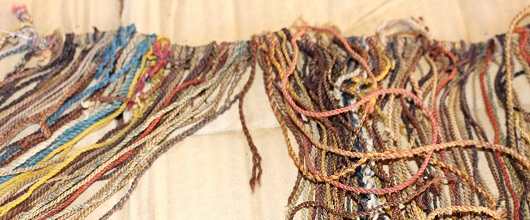Lost writing of the Incas discovered

The lost “written” language of the Incas, which used twists of coloured animal hair rather than ink and paper, has been partially deciphered by an anthropologist at the University of St Andrews, potentially shedding light on the mysterious South American civilisation.
Dr Sabine Hyland, of the School of Philosophy, Anthropology and Film Studies at the University, has managed to translate the meaning of some names recorded on these twisted cords, which are known as “khipus”.
This discovery opens up the possibility of deciphering the mysterious Inka string writing, which would dramatically increase the current understanding of Inka civilization, the largest indigenous empire of the Americas.
It had already been established that the khipus – which are made using cotton or different coloured fibre from animals such as alpacas, llamas and deer – were used by the Inkas to record numerical accounts, but until recently, there was no evidence they had been used to record narratives.
However, Dr Hyland has now discovered that the khipus were used in a logosyllabic system like Classic Mayan, where each logo (in this case a khipu pendant cord) represents a phonetic syllable – the first evidence that the Inkas possessed phonetic writing.
She has managed to phonetically decipher two lineage names on the khipus so far, and is continuing field and archival research to decipher the rest.
 Dr Hyland was able to make her discovery after being granted the rare opportunity to examine two logosyllabic khipus guarded by residents of the remote village of San Juan de Collata in the Peruvian Andes, in research funded by the National Geographic Society.
Dr Hyland was able to make her discovery after being granted the rare opportunity to examine two logosyllabic khipus guarded by residents of the remote village of San Juan de Collata in the Peruvian Andes, in research funded by the National Geographic Society.
Village authorities invited Hyland to examine their khipus, which were created in the 18th century as letters exchanged by local leaders in a revolt against Spanish authority, and are the only Andean phonetic khipus ever identified.
The Collata khipus, as they are known, contrast sharply with the regional accounting khipus. They are the first ever reliably identified as narrative epistles by the descendants of their creators and indicate a widespread, shared writing system used in the Huarochiri province in the 18th century.
Analysis of the khipus revealed they contain 95 different symbols, a quantity within the range of logosyllabic writing systems, and notably more symbols than in regional accounting khipus. At the end of each khipu, three-cord sequences of distinct colours, fibres and ply direction appear to represent lineage (“ayllu”) names.
The Collata khipus express syllables in a profoundly Andean fashion, using differences among the fibres of various animals, such as vicuña, alpaca and deer to indicate meaning. The reader must often feel the cords by hand to distinguish the fibre sources of these three-dimensional texts.
Collata khipus share unique structural features with Inka animal fibre khipus, underscoring the continuity between Inka woollen khipus and the Collata ones. The epistolary khipus of Collata indicate that Andean khipus could constitute an intelligible writing system.
Category Research